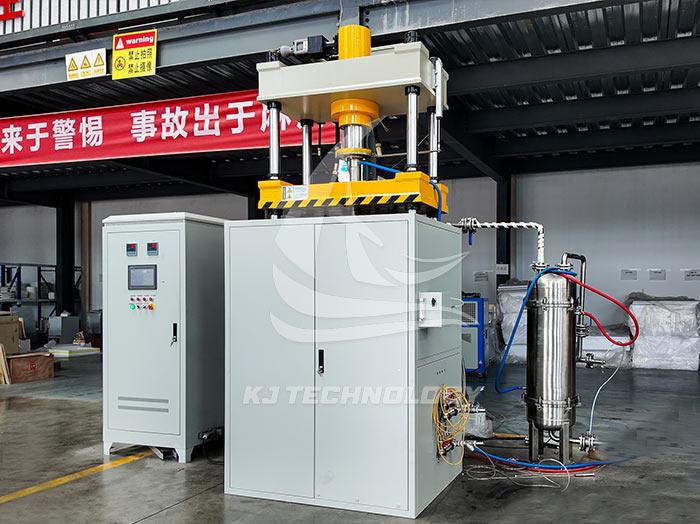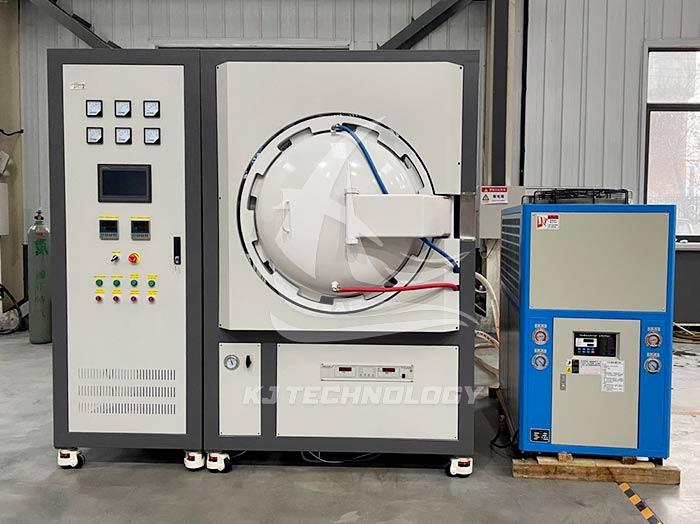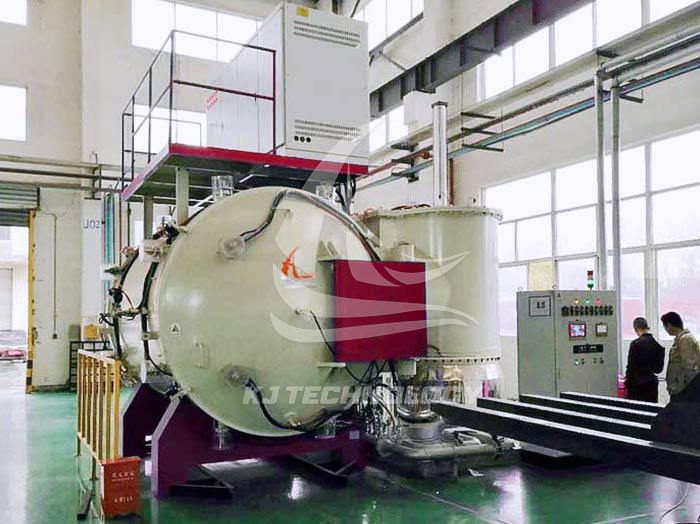What is the principle of the box type vacuum muffle furnace?
 05-13-2025 Author: KJ technology
05-13-2025 Author: KJ technology
The principle of the box type vacuum muffle furnace is based on the synergistic effect of vacuum environment and high-temperature heating, which achieves oxidation suppression, thermodynamic optimization, and precise atmosphere control during material processing by eliminating gas inside the furnace. The following analysis will be conducted from three aspects: core structure, working mechanism, and key principles:
1. Core structure and functional modules
The box type vacuum muffle furnace is mainly composed of the following parts, and each module cooperates to achieve its functions:
Vacuum Chamber
Material: Typically made of stainless steel or carbon steel lined with ceramic fibers, it is resistant to high temperatures and can withstand vacuum pressure.
Function: To provide a sealed space, the gas inside the furnace is pumped to a high vacuum state (generally ≤ 10 ⁻ ² Pa) through a vacuum pump, reducing the oxidation or pollution of materials by oxygen, nitrogen, etc.
Heating system
Heating element: Resistance wires (such as nickel chromium alloy) or silicon molybdenum rods are commonly used to generate Joule heating through electric current.
Temperature control: Thermocouples monitor the temperature inside the furnace in real-time, and PID controllers adjust the heating power to achieve precise temperature control (usually ranging from room temperature to 1600 ℃).
vacuum system
Vacuum pump: a combination of mechanical pump (roughing) and molecular pump (high vacuum) to quickly establish and maintain a vacuum environment.
Valves and pipelines: Control gas inlet and outlet, support vacuum maintenance or atmosphere replacement (such as filling with inert gas).
Insulation and sealing
Insulation layer: Ceramic fibers or refractory bricks reduce heat loss and improve energy efficiency.
Sealing element: Fluororubber or metal sealing ring ensures the airtightness between the furnace door and the cavity.
2. Working mechanism
The workflow of the box type vacuum muffle furnace can be divided into the following stages:
Vacuum pumping stage
Start the vacuum pump to extract gas from the furnace, reduce oxygen partial pressure, and suppress material oxidation reaction.
Example: In metal sintering, a vacuum environment can prevent the formation of oxide films on the metal surface and improve the sintering density.
heating phase
The heating element is energized to raise the temperature, and is transmitted to the sample through thermal radiation.
Key point: In a vacuum environment, thermal convection is suppressed, and heat conduction and radiation become the main heat transfer methods. It is necessary to optimize the furnace structure to ensure temperature uniformity (usually temperature difference ≤ ± 5 ℃).
Atmosphere control (optional)
According to the process requirements, inert gas (such as argon) or reducing gas (such as hydrogen) is filled to further regulate the reaction environment.
Application: In the preparation of semiconductor materials, filling high-purity argon gas can prevent the introduction of impurities.
Cooling and Sampling
After stopping heating, lower the temperature through natural cooling or forced air cooling, and remove the sample after the vacuum is released.
3. Key principles
The role of vacuum environment
Inhibition of oxidation: Reduce the oxygen partial pressure to below 10 ⁻ Pa, so that the Gibbs free energy of metal oxidation reaction becomes positive, making the reaction difficult to proceed.
Reduce volatilization loss: At high temperatures, vacuum can lower the partial pressure of volatile components in materials, reducing their evaporation.
Improve heat treatment effect: eliminate gas convection interference, make temperature distribution more uniform, and avoid local overheating or undercooling.
High temperature heating principle
Resistance heating: When current passes through a heating element, heat (Q=I 2Rt) is generated due to the resistance, and the heat is transferred to the sample through radiation.
Temperature uniformity control: By optimizing the layout of heating elements (such as using a three-dimensional surround design) and insulation layer design, thermal gradients can be reduced.
The synergistic effect of atmosphere control
Inert gas protection: Inert gases such as argon can isolate oxygen and also serve as heat carriers to transfer heat.
Reductive atmosphere: Hydrogen can be used to reduce metal oxides or provide a carbon source in carbonization processes.
4. Application scenarios and advantages
Typical applications
Material sintering: densification treatment of ceramic and metal powders.
Heat treatment: metal annealing, quenching, and tempering.
Chemical Vapor Deposition (CVD): Deposition of thin film materials under vacuum or specific atmosphere.
Sample ashing: Removing organic matter and retaining inorganic components in analytical chemistry.
Core advantages
High purity processing: avoids oxidation and impurity contamination, and improves material performance.
Low temperature sintering: Under vacuum environment, some materials can be densified at lower temperatures, saving energy.
Process flexibility: Supports multiple heat treatment processes under vacuum, inert atmosphere, or reducing atmosphere.
5. Summary
The box type vacuum muffle furnace suppresses oxidation and volatilization through a vacuum environment, combines high-temperature heating to achieve physical or chemical changes in materials, and further optimizes process conditions through atmosphere control. The core principle is to create a low oxygen, low pollution, and thermodynamically stable processing environment, suitable for fields with strict requirements for material purity and performance. In practical applications, it is necessary to adjust the vacuum degree, temperature, and atmosphere parameters reasonably according to the material characteristics and process requirements to maximize the performance of the equipment.








